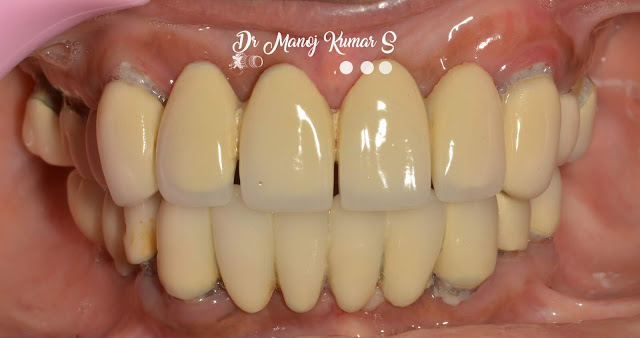Case 44: All on 4 maxillary arch- System- Straumann implants
Case 44: All on 4 maxillary arch- System- Straumann implants
As i have discussed the pros of an all on 4 implants with immediate loading in my previous cases, I am directly going ahead with a case discussion here. The patient had a history of single maxillary metal based complete denture opposing a natural dentition form 3.5 to 4.5 with an RPD for the posteriors. He did present with a root stump in 4.7 After CBCT analysis, we decided to go in for an all on 4 procedure as the patient was not satisfied with the removable maxillary denture.
The system chosen was Straumann Roxolid SLA active. The entire procedure was carried out under local anesthesia. And the impression copings were splinted using pattern resin and a trayless impression was made with addition silicone. Further jigtrial and jawrelation followed by try-in was carried out. Final prosthesis was torqued over the multi-unit abutments at 15 NCM as all the abutments were angulated to 15 degree for anteriors and 30 degrees for posteriors.
Screw access holes were closed with teflon followed by flowable composite. and occlusion assessed and adjusted. Further treatment involving extraction of 4.7 with a new cast partial denture for the lower was planned by the GP who referred the case for implants to me.
This case was done by me at Parasu Dental Hospital, Chennai.
As i have discussed the pros of an all on 4 implants with immediate loading in my previous cases, I am directly going ahead with a case discussion here. The patient had a history of single maxillary metal based complete denture opposing a natural dentition form 3.5 to 4.5 with an RPD for the posteriors. He did present with a root stump in 4.7 After CBCT analysis, we decided to go in for an all on 4 procedure as the patient was not satisfied with the removable maxillary denture.
The system chosen was Straumann Roxolid SLA active. The entire procedure was carried out under local anesthesia. And the impression copings were splinted using pattern resin and a trayless impression was made with addition silicone. Further jigtrial and jawrelation followed by try-in was carried out. Final prosthesis was torqued over the multi-unit abutments at 15 NCM as all the abutments were angulated to 15 degree for anteriors and 30 degrees for posteriors.
Screw access holes were closed with teflon followed by flowable composite. and occlusion assessed and adjusted. Further treatment involving extraction of 4.7 with a new cast partial denture for the lower was planned by the GP who referred the case for implants to me.
This case was done by me at Parasu Dental Hospital, Chennai.













Comments